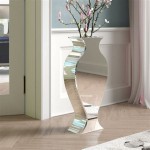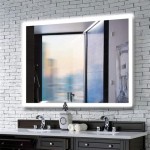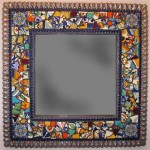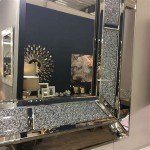Painting Antique Mirror Frames: A Comprehensive Guide
Antique mirror frames, often ornate and intricately detailed, can add significant character to any space. However, time can take its toll, leaving them looking faded, chipped, or simply out of sync with current decorating schemes. Painting an antique mirror frame offers a way to restore its beauty or refresh its aesthetic appeal. This process requires careful consideration and meticulous execution to preserve the frame's historical value and inherent charm. This article provides a comprehensive guide to painting antique mirror frames, covering preparation, painting techniques, and finishing touches.
Before undertaking any painting project, it is crucial to assess the existing condition of the mirror frame. Look for signs of damage such as cracks, loose joints, or flaking paint. Determine the type of material the frame is made from, as this will influence the choice of paint and preparation methods. Common materials for antique mirror frames include wood, gesso, plaster, and metal, or a combination thereof. Gesso, a white paint mixture consisting of a binder mixed with chalk, gypsum, pigment, or a combination of these, is often used as a base coat and can be quite delicate.
Understanding the frame's history and its original finish is also important. If the frame is particularly valuable or historically significant, consider consulting with a professional conservator before attempting any restoration or painting. Preserving the original finish, if possible, is often preferable for maintaining the antique's value. If painting is the chosen route, careful documentation, including photographs, can be helpful for future reference.
Key Point 1: Preparation is Paramount
Proper preparation is the foundation for a successful painting project. Neglecting this step can lead to poor adhesion, uneven coverage, and ultimately, a less than satisfactory result. Preparation involves cleaning, repairing, and priming the frame.
The first step is to carefully remove the mirror from the frame. This usually involves removing fasteners or clips from the back of the frame. Exercise caution to avoid damaging the mirror or the frame during this process. Store the mirror in a safe place, wrapped in protective material such as bubble wrap or moving blankets.
Next, thoroughly clean the frame. Remove dirt, dust, and grime using a soft brush, vacuum cleaner with a brush attachment, or a damp cloth. For stubborn dirt or grease, use a mild detergent solution. Avoid harsh chemicals or abrasive cleaners, as these can damage the finish or underlying material. Rinse the frame with clean water and allow it to dry completely before proceeding.
Once the frame is clean, inspect it for any damage. Repair any cracks, chips, or loose joints using appropriate fillers or adhesives. For wood frames, wood filler can be used to fill cracks and chips. For gesso or plaster frames, a specialized gesso or plaster repair compound is recommended. Apply the filler according to the manufacturer's instructions and allow it to dry completely. Once dry, sand the filled areas smooth using fine-grit sandpaper (220-grit or higher). Be careful not to sand away the surrounding original finish unnecessarily.
Priming is an essential step that ensures proper adhesion of the paint and provides a uniform surface for painting. Choose a primer that is compatible with both the frame material and the chosen paint. For wood frames, a wood primer is suitable. For gesso or plaster frames, a gesso primer or a specialized primer for porous surfaces is recommended. For metal frames, a metal primer is necessary to prevent rust and ensure adhesion. Apply the primer in thin, even coats using a brush or spray gun, following the manufacturer's instructions. Allow the primer to dry completely before proceeding to the painting stage. Lightly sand the primed surface with very fine-grit sandpaper (320-grit or higher) to create a smooth base for the paint.
Key Point 2: Selecting the Right Paint and Application Techniques
Choosing the right paint and application techniques is crucial for achieving the desired look and ensuring the longevity of the paint job. Consider the frame's style, the desired finish, and the surrounding décor when selecting the paint.
Various types of paint are suitable for painting antique mirror frames, including latex paints, oil-based paints, and acrylic paints. Latex paints are water-based, easy to clean up, and have low VOC (volatile organic compound) emissions. They are a good choice for frames that will be subject to frequent cleaning or handling. Oil-based paints offer excellent durability and a rich, glossy finish. However, they require mineral spirits for cleanup and have higher VOC emissions. Acrylic paints are versatile and offer a good balance of durability, ease of use, and low VOC emissions. They are a popular choice for a wide range of painting projects. Consider using paints specifically formulated for furniture or trim work, as these tend to dry to a harder, more durable finish.
The choice of finish also plays a significant role in the overall look of the painted frame. Common finishes include matte, satin, semi-gloss, and gloss. Matte finishes have a flat, non-reflective appearance and are good for hiding imperfections. Satin finishes have a slight sheen and are easy to clean. Semi-gloss finishes are more durable and reflective than satin finishes, making them a good choice for frames that will be subject to wear and tear. Gloss finishes are highly reflective and offer the most durability. They are often used for frames that require a dramatic look.
Apply the paint in thin, even coats using a high-quality brush or spray gun. Brushes are suitable for intricate details and small areas. Choose a brush with soft, synthetic bristles for a smooth finish. Spray guns offer a faster and more even application, especially for large or complex frames. Practice your spraying technique on a piece of cardboard before applying the paint to the frame. Hold the spray gun at a consistent distance from the frame and move it in smooth, overlapping strokes. Avoid applying too much paint in one coat, as this can lead to runs and drips. Allow each coat of paint to dry completely before applying the next coat. Two or three thin coats are usually sufficient for achieving adequate coverage and durability.
For ornate frames with intricate details, consider using specialized painting techniques such as dry brushing or antiquing. Dry brushing involves applying a small amount of paint to a dry brush and then lightly brushing it over the raised areas of the frame. This technique highlights the details and creates a weathered look. Antiquing involves applying a glaze or stain to the painted frame and then wiping it away to create a aged appearance. Experiment with different techniques to achieve the desired look. Practice on a sample piece before applying the techniques to the frame.
Key Point 3: Finishing Touches and Reassembly
Once the paint has dried completely, apply a protective topcoat to seal the paint and enhance its durability. A clear coat of varnish or lacquer is a good choice for protecting the painted surface from scratches, moisture, and UV damage. Apply the topcoat in thin, even coats using a brush or spray gun, following the manufacturer's instructions. Allow the topcoat to dry completely before reassembling the mirror and frame.
Before reassembling, carefully inspect the newly painted frame for any imperfections. Touch up any areas that need attention using a small brush or cotton swab. Remove any drips or runs with fine-grit sandpaper or a razor blade. Clean the mirror and frame one last time to remove any dust or fingerprints.
Reassemble the mirror and frame, taking care to align the mirror properly. Secure the mirror in place using fasteners or clips. Ensure that the fasteners are tightened securely to prevent the mirror from moving or falling out. If necessary, add padding or shims to the back of the frame to ensure a snug fit.
Once the mirror and frame are reassembled, inspect the finished product for any remaining imperfections. Touch up any areas that need attention and clean the mirror one last time. Hang the newly painted antique mirror frame in a prominent location and enjoy its restored beauty. Regular cleaning and maintenance will help to preserve the frame's beauty for years to come.
The decision to paint an antique mirror frame is a significant one, requiring careful consideration of its value and historical significance. While painting can refresh its appearance and integrate it into a modern context, it is essential to prioritize preservation and employ appropriate techniques to avoid damaging the frame. By following the steps outlined in this guide, individuals can successfully paint antique mirror frames and restore their beauty while respecting their historical integrity.

12 Techniques To Painting Antique Mirrors Hallstrom Home

12 Techniques To Painting Antique Mirrors Hallstrom Home

Chalk Painting And Antiquing A Frame My Vintage Porch Mirror Diy Frames

12 Techniques To Painting Antique Mirrors Hallstrom Home

How To Paint A Mirror Frame Gold Remodelando La Casa

Painting A Mirror Frame Easy Yet Stunning Ideas Girl In The Garage

Chalk Painting And Antiquing A Frame My Vintage Porch Antique Mirror Diy Frames

12 Techniques To Painting Antique Mirrors Hallstrom Home

Diy Mercury Glass Gilded Mirror Made From Old Photo Frames
:max_bytes(150000):strip_icc()/alahome1-a879d69e31be4a9a9ae522028c12926d.jpg?strip=all)
20 Diy Mirror Frame Ideas To Inspire Your Next Project








